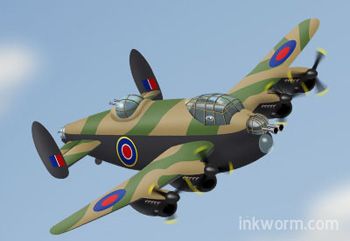An author friend of mine recently wrote a novel that included a chapter about a haunted World War Two Lancaster bomber. I was thinking about the book the other day (yes, I’m talking about you, Rose Zolock), and completely out of the blue I came upon an idea that might help me explain Point of View to authors.
Some new writers have a problem with staying in one character’s POV when writing close third person (and sometimes first person). I’ve tried many ways to explain this, giving my own technique and directing authors to various online resources. I’m not going to go into the fine detail of the various ways to write a POV here – that’s for another day.
But imagine the following scenario. You are walking through a countryside scene (or it could be a town, or even another planet; wherever it is, it represents the setting of your book). You come across an airstrip. On the airstrip is a plane, which will shortly take off for a whirlwind tour. You, the writer, board the plane. Once inside the cockpit, with your helmet and goggles safely in place, you are anonymous. Apart from the fact that someone is flying the plane, no one would know you were there, let alone what you look like or what opinions you may hold. The plane takes off under your expert hand, into the world you have created – the world of your novel. Imagine the plane has now become your character. You, the writer, are directing that character, but invisibly, looking out of the character’s eyes on behalf of the reader.
When you’re writing, picture yourself sitting in the cockpit – the mind of your character – looking out of the front windscreen: the character’s eyes. You are enclosed in the cockpit, and everything happening outside it you experience from that position.
There might be other planes in the sky around you, but you can’t get into their cockpits (even Rose’s phantoms couldn’t do that). To try to do so would endanger your life and the lives of the people and places around you – the other characters in and the setting of your novel. It would damage the whole book.
We can keep this metaphor going. When you’ve flown your character through that scene to its natural conclusion, you can skilfully land the plane, alight, get into another cockpit and fly another character to continue their journey (in a new scene, with a section break, which signals to the reader you have changed planes). And the beauty of fiction is – you can walk (or teleport) from the first airstrip to another one over what might be miles, or, as I mentioned before, even to another planet!
Have a great trip!




